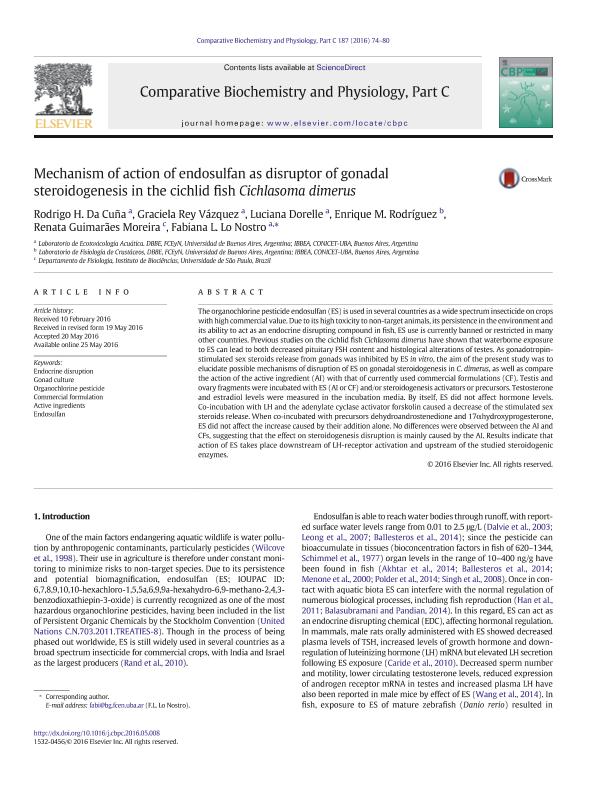Artículo
Mechanism of action of endosulfan as disruptor of gonadal steroidogenesis in the cichlid fish Cichlasoma dimerus
Da Cuña, Rodrigo Hernán ; Rey Vázquez, Graciela; Dorelle, Luciana Soledad
; Rey Vázquez, Graciela; Dorelle, Luciana Soledad ; Rodriguez, Enrique Marcelo
; Rodriguez, Enrique Marcelo ; Guimarães Moreira, Renata; Lo Nostro, Fabiana Laura
; Guimarães Moreira, Renata; Lo Nostro, Fabiana Laura
 ; Rey Vázquez, Graciela; Dorelle, Luciana Soledad
; Rey Vázquez, Graciela; Dorelle, Luciana Soledad ; Rodriguez, Enrique Marcelo
; Rodriguez, Enrique Marcelo ; Guimarães Moreira, Renata; Lo Nostro, Fabiana Laura
; Guimarães Moreira, Renata; Lo Nostro, Fabiana Laura
Fecha de publicación:
09/2016
Editorial:
Elsevier Science Inc
Revista:
Comparative Biochemistry And Physiology. Toxicology & Pharmacology
ISSN:
1532-0456
Idioma:
Inglés
Tipo de recurso:
Artículo publicado
Clasificación temática:
Resumen
The organochlorine pesticide endosulfan (ES) is used in several countries as a wide spectrum insecticide on crops with high commercial value. Due to its high toxicity to non-target animals, its persistence in the environment and its ability to act as an endocrine disrupting compound in fish, ES use is currently banned or restricted in many other countries. Previous studies on the cichlid fish Cichlasoma dimerus have shown that waterborne exposure to ES can lead to both decreased pituitary FSH content and histological alterations of testes. As gonadotropin-stimulated sex steroids release from gonads was inhibited by ES in vitro, the aim of the present study was to elucidate possible mechanisms of disruption of ES on gonadal steroidogenesis in C. dimerus, as well as compare the action of the active ingredient (AI) with that of currently used commercial formulations (CF). Testis and ovary fragments were incubated with ES (AI or CF) and/or steroidogenesis activators or precursors. Testosterone and estradiol levels were measured in the incubation media. By itself, ES did not affect hormone levels. Co-incubation with LH and the adenylate cyclase activator forskolin caused a decrease of the stimulated sex steroids release. When co-incubated with precursors dehydroandrostenedione and 17αhydroxyprogesterone, ES did not affect the increase caused by their addition alone. No differences were observed between the AI and CFs, suggesting that the effect on steroidogenesis disruption is mainly caused by the AI. Results indicate that action of ES takes place downstream of LH-receptor activation and upstream of the studied steroidogenic enzymes.
Archivos asociados
Licencia
Identificadores
Colecciones
Articulos(IBBEA)
Articulos de INSTITUTO DE BIODIVERSIDAD Y BIOLOGIA EXPERIMENTAL Y APLICADA
Articulos de INSTITUTO DE BIODIVERSIDAD Y BIOLOGIA EXPERIMENTAL Y APLICADA
Citación
Da Cuña, Rodrigo Hernán; Rey Vázquez, Graciela; Dorelle, Luciana Soledad; Rodriguez, Enrique Marcelo; Guimarães Moreira, Renata; et al.; Mechanism of action of endosulfan as disruptor of gonadal steroidogenesis in the cichlid fish Cichlasoma dimerus; Elsevier Science Inc; Comparative Biochemistry And Physiology. Toxicology & Pharmacology; 187; 9-2016; 74-80
Compartir
Altmétricas



